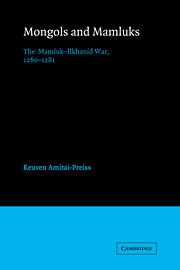Book contents
- Frontmatter
- Contents
- List of illustrations
- Preface
- List of abbreviations
- Notes on dates and transliteration
- Introduction
- 1 The historical background
- 2 The battle of ʿAyn Jālūt
- 3 The formulation of anti-Īlkhānid policy
- 4 The search for a second front
- 5 Military and diplomatic skirmishing
- 6 The secret war
- 7 Baybars's intervention in Seljuq Rūm
- 8 Baybars's posthumous victory: the second battle of Homs (680/1281)
- 9 The Mamluk–Īlkhānid frontier
- 10 Mamluks and Mongols: an overview
- Maps
- Genealogical Tables
- Glossary
- Bibliography
- Index
7 - Baybars's intervention in Seljuq Rūm
Published online by Cambridge University Press: 23 November 2009
- Frontmatter
- Contents
- List of illustrations
- Preface
- List of abbreviations
- Notes on dates and transliteration
- Introduction
- 1 The historical background
- 2 The battle of ʿAyn Jālūt
- 3 The formulation of anti-Īlkhānid policy
- 4 The search for a second front
- 5 Military and diplomatic skirmishing
- 6 The secret war
- 7 Baybars's intervention in Seljuq Rūm
- 8 Baybars's posthumous victory: the second battle of Homs (680/1281)
- 9 The Mamluk–Īlkhānid frontier
- 10 Mamluks and Mongols: an overview
- Maps
- Genealogical Tables
- Glossary
- Bibliography
- Index
Summary
At that time the Sultan of Egypt entered with his power into the realm of Turkey. He killed and drove out all the Tartars that were there and took many lands and cities, because a traitor that Abagha had made head official [chevetaine] of Turkey, who was called Parvana, had turned and became obedient to the Sultan of Egypt, and exerted himself to drive the Tartars out of Turkey.
HetʿumMamluk incursions over the border may have disconcerted the Īlkhāns and their local commanders and confederates, but they did not seriously endanger the integrity and security of the Īlkhānid kingdom. In 675/1277, however, Bay bars mounted a major invasion of Rūm, in the course of which he defeated a Mongol army at Abulustayn (Elbistan) and occupied the Seljuq capital of Qaysariyya (Kayseri, Caesarea). Baybars's goals are not known. Perhaps he had hoped to wrest Seljuq Rūm from the Mongols, thinking that he would find significant support from various military elements in that country. Possibly, however, his plan was more modest, and he had only launched a massive raid in order to destabilize the Mongols, test their reactions and try his own troops.
Early Mamluk interest in Seljuq Rūm
In the aftermath of the victory at Köse Dagh (641/1243), the Mongols gained control over the Seljuq kingdom in Rūm. Mongol rule, however, was indirect, and the Seljuq sultans, or rather their senior officials and officers, still ran the country, although under Mongol supervision. Actual Mongol presence in Rum was minimal.
- Type
- Chapter
- Information
- Mongols and MamluksThe Mamluk-Ilkhanid War, 1260–1281, pp. 157 - 178Publisher: Cambridge University PressPrint publication year: 1995
- 1
- Cited by

